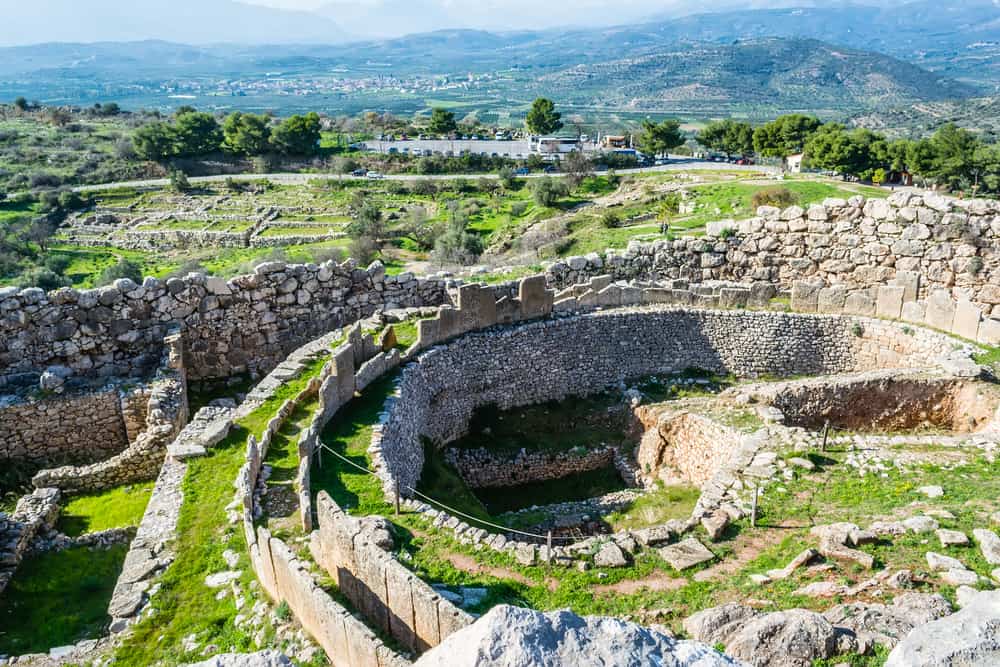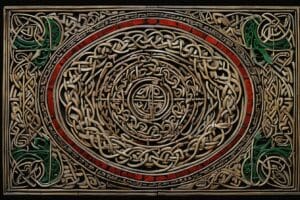Mycenae, Greece: 6 Important Facts

Updated On: November 08, 2023 by Dina Essawy
The majestic ruins of the fabled ancient city of Mycenae draw tourists from all over the world. In reality, this is one of Greece’s most significant archaeological sites, and the earliest artefacts discovered there date to 3,000 BC.
Heinrich Schliemann, a German amateur archaeologist, conducted excavations in the Mycenae region of Greece in 1870. This was significant since Mycenae was previously believed to have only existed in myths and literature. The research of Schliemann demonstrated the veracity of the data presented by Homer in The Iliad and the eminent geographer Pausanias. The Iliad served as a crucial source of information in determining where to begin the excavation process.
The Archaeological Museum of Mycenae now has many of the discovered artefacts on exhibit. It had an acropolis, according to Greek legend, that dates back to the 13th century BC. It was reconstructed at this time and was built on sturdy, five-meter-thick Cyclopean walls.
The huge size of the blocks utilised in this design is what gives it its name. The strong Cyclops was credited with creating this masterpiece in a legendary account. The Gate of the Lions at this wall’s entrance is the oldest example of monumental sculpture in all of Europe and not only in Greece.
Although the Mycenaeans are well-known for being skilled warriors and hunters, the aforementioned discoveries reveal more about their activities and way of life. The pottery shows that Mycenae and other city-states engaged in substantial trade. Fragments of Mycenaean pottery have been discovered as far away as Egypt and Italy.
Mycenae is also known for relying on reputable traders who are committed to exchanging basic materials like oil, animal skins, and other raw materials for expensive items like jewels from Crete, Egypt, and Asia Minor. While, unlike the Minoans, Mycenaean society reserved riches for the king and other authorities and did not distribute them to the general populace, ivory sculptures, gold decorations, and jewellery also provide an impression of their luxury.
Numerous bronze weaponry, as well as domestic objects like cups, were discovered. Another significant aspect of Mycenaean culture is the burials. Before 1500 BC, the notable members of Mycenaean society were interred in tombs with a deep holes.
However, the renowned Tholos tombs were built after this century. These tombs, which are large chambers carved into the side of a hill, are essentially a colossal construction. Such societies are known for burying their leaders in such opulent settings.
In addition, the Tholos tombs were discovered in 1870. The golden mask of Agamemnon, together with other masks discovered in the graves of significant Mycenaean chieftains, is the most significant item discovered. These masks demonstrate the Mycenaean custom of interring significant people with a golden mask.
Mycenae Greek Mythology
The Mycenaean period lasts for more than four centuries, following which Mycenae vanished and was forgotten to the point where many people believed it never existed. The mythology and literary sources have served as the only historical evidence of the Mycenaean empire’s existence.
Homer, for instance, beautifully described the Mycenaean battle with Troy, albeit this was regarded as fiction. Mycenae’s history was significant to Greece and had a significant impact on its development.
Heinrich Schliemann, an amateur archaeologist, used the facts provided by Homer as the foundation for his research and found the city of Troy. Then, in the northern Peloponnese, he found the fabled city of Mycenae. These two excavations proved that Homer’s epics were not merely works of fiction but also included a lot of facts.
The consolidation of power in the hands of the kings was a distinctive feature of the monarchical structure of the Mycenaean civilization. These riches were not distributed to the rest of society at Mycenae, in contrast to Minoan Crete. As this civilisation had a significant military profile, marked by encouraging conflicts and invading areas, the Mycenaean rulers were perpetually at war.
The Mycenaean army was included among the Egyptian raiders, according to the extant documents discovered in Asia Minor and the Middle East. When the Minoan civilisation weakened as a result of a string of earthquakes, their capacity for battle was also demonstrated. It appears that the Mycenaean forces used this opportunity to capture Crete.
The Cyclopean Walls, the enormous walls composed of enormous stones that protected the Mycenaean settlements, also represent the battle character of the Mycenaean society. According to the tale, humans couldn’t have built these walls with the technology available at the time, thus Cyclops must have done it.
The art of Mycenae, which in this case was unmistakably defined by themes of combat and hunting, was profoundly influenced by this military atmosphere. The Minoan manner and way of life, which were more devoted to daily living, contrast with this.
On the other hand, the Mycenaeans eventually imposed their civilization upon the Aegean inhabitants following the invasions. Trading was another activity besides war and invasions. Trade was developed by the Mycenaeans, albeit not to the same extent as by the Minoans.
In return for beautiful items like jewellery, they frequently traded raw materials like oil, animal skins, and other raw materials from Crete, Egypt, and Asia Minor, all of which used to stand out in the manufacturing of such products. However, as was already established, only a few wealthy officials and monarchs were able to partake in this activity’s grandeur.
As tributes to the deceased, such pricey and exquisite items have frequently been found in the tombs of monarchs and other members of the royal family. The tholos, or Mycenaean tombs, featured vaulted roofs and two rooms: a smaller one for the deceased and a bigger one for the gifts.
The Treasury of Atreus, which is just a short stroll from the archaeological site of Mycenae and is thought to be the grave of King Agamemnon, is the most well-known vaulted tomb. The construction of tombs for undesirables or criminals beyond the city walls is particularly intriguing.
Near Nafplion lies the historical town of Mycenae, which has a great number of sites and monuments. Nafplion has intriguing specimens of Byzantine architecture despite the absence of any churches there.
One such intriguing chapel located inside the castle walls is Agios Andreas. The church of Saint Spyridon has a special historical significance because it was where Kapodistrias, the first Greek governor, was killed in 1831.
Panagia church may be found at Nafplion near the harbour. The church of Agios Nikolaos, which is Nafplion’s oldest church, is located in the middle of the city. The 16th-century Agios Georgios was the ancient town’s Metropolis Cathedral. Visitors will find a variety of attractions at both locations.
Mycenae- How is the Weather Like?
The high altitude and different locations of the Peloponnese have different climates. The year-round tourism in Mycenae benefits from the temperate climate. Mycenae experiences typical Mediterranean summers with highs that can reach above 35°C. Although the winters are mild, there are periods when it rains or snows heavily.
Mycenae Geography
Mycenae is one of the most significant archaeological sites in Greece and is renowned for its fabled past. Between Argos and Nafplion in the Peloponnese region is where you may find it.
Mycenae, the kingdom of Agamemnon, the leader of the Greeks in the fight against Troy, is where the ancient Mycenaean civilisation flourished. The Mycenaean Acropolis was constructed between two steep hills at a height of around 280 metres above sea level. The hills cannot see it.
Mycenae’s geography is quite fascinating. One of Peloponnese’s most picturesque regions, it is distinguished by majestic mountains that tower over the palaces and archaeological wonders of ancient Mycenae.
Mycenae is primarily distinguished by its barren soil and untamed hills since farming there was tough and quite demanding for the residents due to the region’s harsh terrain. The natural scenery of the area, which closely reflects the entire Peloponnese, is followed by the ancient site of Mycenae.
One of the most significant sites in mainland Greece is the archaeological site of Mycenae, which is situated in the eastern Peloponnese. Mycenae was the most influential town of its day and even served as the inspiration for an entire historical era, the Mycenaean period, which is why it was cited by the epic muse Homer and the geographer Pausanias.
Ever, many scholars did not think that the town of Mycenae existed and believed that it was a creation of Homer until the 1870s when amateur archaeologist Heinrich Schliemann began excavating the site. Schliemann was referred to as the “father of Mycenaean Archaeology” after the excavations at Mycenae, Troy, and Tyrians.
The Mycenaean civilisation existed from 1,600 BC to 1,100 BC, peaking between 1,400 BC and 1,200 BC. According to history, the Mycenaeans had a strict social structure with the monarch at the top and were superb warriors. Although Mycenaean pots have been discovered across the Mediterranean basin, with the majority being found in southern Italy and even in Egypt, they did not much advance the arts, and there is little evidence of widespread trade between Mycenae and other city-states.
On the ancient site of Mycenae, in addition to pots, there were also ivory sculptures, many golden decorations, bronze weapons, jewellery, and household items like cups. Many of these, including the golden mask of Agamemnon, thought to be the death mask of King Agamemnon, were discovered in shaft graves.
On the brow of a hill with a view of the Argos valley, Mycenae’s fortress was built. Cyclopean walls, which are truly tall walls composed of enormous stones, served as their defence. According to legend, men couldn’t feasibly move such stones due to the primitive technology of the time; hence, the cyclops who created these walls. Due to the two female lions that are etched into the stone above the gate, the entrance to the citadel is known as the Lion Gate.
In addition to the Acropolis, which is the highest point in the city and where the monarch would reside, the citadel itself has the ruins of dwellings, cisterns, public buildings, and storehouses. The Treasury of Atreus, Greece’s best-preserved vaulted tomb, lies a short distance from the castle. Very few artefacts were discovered within this tomb during its excavation because it had previously been robbed during the Medieval or Ottoman periods.
The grave of Clytemnestra, the fabled spouse of Agamemnon, is situated close to the fortress. The grave of Aegisthus, who planned the murder of Agamemnon and his mistress Clytemnestra, stands beyond the walls of Mycenae. Aegisthus was not desired by the community, as evidenced by the fact that he was buried beyond the city limits.
The Archaeological Museum, located next to Mycenae’s citadel, is home to several priceless artefacts retrieved from this location. The historic site of Mycenae was designated a UNESCO World Heritage Monument in 1999.
Mycenae- Stone Architecture
Mycenae’s stone architecture is one of a kind and was influenced by several civilizations, including the Minoans of Crete. Palaces, fortifications, towns, and burial monuments were among the significant architectural remnants of the Mycenaean civilisation that were discovered as a result of archaeological investigations that got underway in the second half of the 19th century.
The surrounding area is dominated by the Mycenaean strongholds that are perched above the cliffs and are enclosed by sturdy walls. The palaces, which are constructed in prominent places and include large building complexes and paved yards, are of great significance.
The distinctive Mycenaean tombs, the most renowned of which is the tomb of Agamemnon (also known as the Treasury of Atreus), are an essential component of the city’s architecture. Other graves nearby may be those of Agamemnon’s forefathers.
The enormously massive stone blocks that define magnificent defence buildings like the fortification walls of the Acropolis, the Lion Gate, and the Cyclopean walls are one of the distinguishing characteristics of Mycenaean architecture (the myth says that they were constructed by the Cyclops).
This civilization’s architectural skills went beyond only physical structures; they also made significant advancements in the water and transportation systems. Mycenae’s fabled architectural creations are unparalleled in the entire globe and continue to have a significant influence on Greek history.
- Mycenae Atreus Treasury
Mycenae’s Treasury of Atreus One of the most well-known structures in Mycenae is the Treasury of Atreus, sometimes referred to as the Tomb of Agamemnon, the mythological ruler of Mycenae.
It is located just a short stroll from the historic city. In reality, the Treasury of Atreus is a Tomba domed tomb made of stone, as they are frequently seen in the Peloponnese.
However, this tomb had been stolen centuries before and was only partially visible when Schliemann visited Mycenae in 1879. This led scholars to imagine that it housed gold and other costly offerings within, which is how the tomb got its name.
Not to add, Atreus was the ruler of Mycenae and the father of Agamemnon. A 36-meter-long narrow walkway leads to the tomb’s entrance, which includes a 120-ton-plus triangular lintel stone over the opening.
The vaulted ceiling and interesting echo that the inside of the tomb produces. The Treasury of Atreus, which was built in 1250 BC, is 13.5 metres high and 14.5 metres in circumference.
In actuality, until the completion of the Pantheon in Rome, it was the highest dome in existence. Another unexpected feature is that red porphyry and green alabaster, which were extremely uncommon painting colours at the period, were used to adorn the interior of this tomb.
- Mycenae Cyclopean Walls
The Cyclopean Walls of Mycenae are notable for being constructed from enormous limestone rocks that have been haphazardly placed together. The ancient people said that the Cyclops erected these gates because it was difficult for men to move such large stones, which are exceedingly large.
The walls were given the name Cyclopean Walls for this reason. It is noteworthy that these walls fit together quite coarsely since the hammer was rarely used to build them. With smaller limestone, the fractures and openings between the stones were filled.
These Cyclopean walls, which date to the 13th century BC, are what make Mycenaean architecture unique. Archaeologists have noted that Tyrins and Argos, two other Mycenaean towns, also exhibit a similar style of construction.
However, Cyclopean architecture was split into four styles by Harry Thurston Peck in 1898. The first design uses larger and smaller stones spaced at different intervals. The stones in the second type are neatly shaped polygons. The fourth type is distinguished by its rectangular stones of variable height, whereas the third style is defined by a stone of unequal size but the same height. Mycenae’s walls adhere to the third style.
- Mycenae Archaeological Museum
At the entrance to the historic site, next to the Lion Gate, is where visitors may find the Archaeological Museum of Mycenae. It was finished in 2003 and spans a vast space with three floors, and only two of the rooms are used for the show. The collection consists of beautifully designed clay, pottery, sculptures, murals, and jewellery items.
A replica of the Golden Mask of Agamemnon, which was discovered in the Treasury of Atreus but is now housed in the Archaeological Museum of Athens, is on display in one of the chambers. More than 2000 artefacts from the Mycenae ancient site and its surrounds are on display in the museum.
It is also important to note that the museum serves as a replica of the Mycenaean site, allowing visitors to have a glimpse of its fascinating past or go back in time. The museum’s contemporary structure has a total floor area of 2,000 square metres.
The museum is built in three storeys and contains discoveries made during excavations in Mycenae, an ancient city. Only three rooms on two floors are used as display spaces; the majority of the structure is used for storage and the development of the finds.
The artefacts are from Mycenae and the surrounding area, and they span from the Copper Era, which began approximately 3,000 B.C., to the Hellenistic period, which began in the second century B.C. There are over 2,500 exhibits, most of which are made of ceramic and include jewellery, murals, tools, and weaponry. The gold jewellery in particular, with its intricate patterns, is stunning.
A replica of the Golden Mask of Agamemnon, a funerary mask discovered in the Treasury of Atreus, is also on display in one of the chambers. The National Archaeological Museum in Athens is home to the original mask, a funerary mask composed of pure gold. Although it is not proven, archaeologist Schliemann, who discovered Mycenae, thought it was King Agamemnon’s funeral mask.
The first chamber of the Archaeological Museum of Mycenae features ceramic artefacts from the historic town and is devoted to the daily lives of the Myceneans. The second chamber has exhibits from graves, such as gifts for the deceased, and is devoted to life beyond death.
The third room is devoted to the ideas of religion, science, art, government, and trade as they were practised by the Mycenaean civilisation. There are wall pillars explaining the history of Mycenae and its excavation near the museum’s entrance. A replica of the old site is also located directly across from the entrance.
- Mycenae lion gate
The entrance to Mycenae’s walled citadel is marked by the Lion Gate. Two lions are shown beneath a triangle on a stone above the entry gate, which is around 10 feet wide and high. Although the metal heads of the lions in the inscription are said to have been stolen long ago.
Additionally, the lions are seen resting their paws on an altar and flanking the sides of a pillar, which was possibly a representation of authority. As you enter through the gates, there is a tiny opening inside the rock wall that many people think was either a guard post or intended to house guard dogs.
Over the years, the Lion Gate has come to represent the whole Mycenae archaeological complex. A wooden door was used in the past to close the entryway. The door used to lock with a wooden bar and opened inward.
Mycenae Nightlife
Except for a few pubs in the new hamlet, Mycenae has no nightlife. Tolo and Nafplion are the nearest towns, featuring pubs and restaurants along the shoreline as well as a few clubs that are open all night.
- Mycenae Mezedokipos: A 100-year-old company that has been operated by the same family for three generations combines the historic culinary culture that made the restaurant renowned with contemporary accents on delectable meals to appeal to aficionados of the new generation’s cuisine. a fresh option in the region.
- Mycenae Achilleus: The inspiration for Achilleus Restaurant sprang from a love of authentic Greek food and 30 years of expertise in providing first-rate service. The proprietors have developed a nicely designed area with seats for about 500 people inside a welcoming and family-oriented setting.
Achilleus Restaurant can go above and beyond your expectations in any project with the proper planning and top-notch service as the fundamental instruments of this establishment.
Along with conferences, Achilleus also organises exhibitions, wedding celebrations, and baptisms. Customers may take advantage of the delicious cuisine and the lovely environment in the freshly remodelled space. Every situation benefits from having Achilleus.
- Mycenae Kolizeras: The goal of Kolizeras is to combine design with the greatest calibre of comfort and service to provide a space that will inspire, enchant, and astound. The end product is a fine dining establishment that is a piece of beauty in and of itself.
- Mycenae Retro: Retro restaurant has been perfecting and upgrading classic Greek and Italian cuisine for the past 30 years by fusing history with innovation. The emphasis is mostly on the legacy of the Greek and Italian cultures, although unquestionably being impacted by global trends.
- Mycenae King Menelaos: King Menelaos resides and governs in the centre of Mycenae. It has maintained its elegance for more than three decades, and its most recent renovation aimed to completely satisfy even the most exacting clientele. Greek food, a welcoming environment, and exceptional service in the hall or on the balcony are everything you would expect to find in a fabled country.
- Mycenae The Brothers: All-day espresso bar with unique espresso blends that are only available here. drinks, food for brunch or breakfast, and a refreshing draught beer or creative cocktail.
Top-Rated Hotels in Mycenae
- Hotel Mycenae
Akropolis of Aspida is less than 1 mile and the Archaeological Museum of Mycenae is 10 km away from Hotel Mycenae, both of which are in Argos. Room service, baggage storage, and free WiFi are just a few of the amenities offered at this establishment. The hotel includes accommodations for families.
Every room in the hotel has a closet. In addition to having a flat-screen TV, air conditioning, and a safety deposit box, some of the rooms at Hotel Mycenae also feature balconies. A minibar will be available in each room for guests.
Each morning, a breakfast buffet is offered at the hotel. Hotel Mycenae is close to Megaro Trikoupi, the Ancient Theatre of Argos, and the Argos Train Station. The hotel is 89 kilometres from Kalamata Captain Vassilis Constantakopoulos Airport, which is the closest airport.
- Morfeas Hotel
It is located in Argos’s old district and provides accommodations with balconies that look out over St. Peter’s Square or the nearby pedestrian area. There is free wifi available all across the place and a front desk is open 24/7. 24-hour room service is available.
The Morfeas Hotel offers air-conditioned rooms with mini-fridges and flat-screen TVs with cable channels. The private bathroom has soft, fluffy towels, a hairdryer, and complimentary amenities. Every day, a hearty breakfast buffet is offered, and you may have it in the comfort of your accommodation.
Before going for a walk in the city and visiting different local shops, you may get your favourite coffee or drink at the Morfeas bar. Nafplion is only 10 kilometres distant, Athens is 120 km away, and Mycenae is an archaeological site that can be reached in 15 minutes by car. You may get directions to the locations you’re interested in seeing at the front desk.
- Palladion Boutique Hotel
The Palladion Boutique Hotel, which is situated in Argos Town’s main square, has distinctively furnished rooms with balconies. It offers massage therapy and a Turkish steam room, and the public spaces have free WiFi. Air conditioning, a satellite TV, a DVD player, and video games are included in every contemporary room.
Additionally, they offer a minibar, ironing equipment, a safe, and a bathroom with free amenities. The Palladion’s dining room offers a breakfast buffet for guests to enjoy as they start their day. You might have it served inside the space. At the on-site snack bar, they may also indulge in a quick meal or beverage.
- Theoxenia Hotel
Theoxenia Hotel in Argos, Greece, offers 1-star lodging and is located 2.8 kilometres from Aspida’s Akropolis and 2.9 km from the city’s train station. The 1-star hotel features rooms with air conditioning, free WiFi, and private bathrooms. It also includes a patio.
The balconies of the apartments offer views of the city. There is a television in each hotel room. Each room at Theoxenia Hotel is furnished with towels and bed linens. Megaro Trikoupi, Dikastiriou Square, and the Ancient Theatre of Argos are all popular attractions close to the lodging.
Mycenae Festivals
Argos-Mycenae Event: The Summer Festival of Argos-Mycenae is the most significant in the Mycenae area. From June through September, this event is held at a variety of locations around the area, including the Ancient Theatre of Argos, the Mycenae Archaeological Site, the Nafplion Cultural Centers, and even town squares and schoolyards. Theatre productions, musical concerts, art exhibits, kid’s performances, and thematic evenings are all part of this festival.
Conclusion
The ancient city of Mycenae is situated in Greece’s Peloponnese region, on the lush Argolid Plain, between two bigger hills. One of the main towns of the Mycenaean civilisation that was essential to the development of ancient Greek culture is the Bronze Age acropolis or fortress perched on a hill. Greek mythology also gives Mycenae a significant role, and it has served as a source of inspiration for poets, authors, and painters for many years despite the city’s abandonment more than 2,000 years ago.






